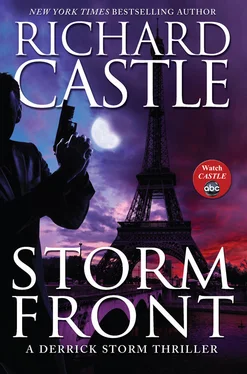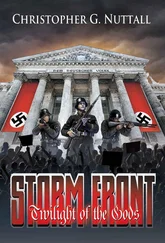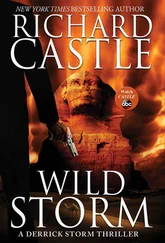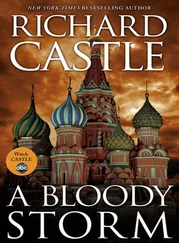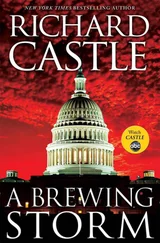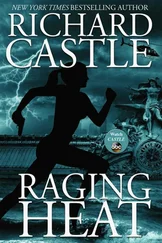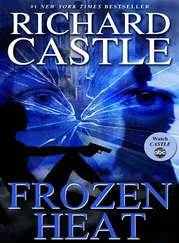Richard Castle - Storm Front
Здесь есть возможность читать онлайн «Richard Castle - Storm Front» весь текст электронной книги совершенно бесплатно (целиком полную версию без сокращений). В некоторых случаях можно слушать аудио, скачать через торрент в формате fb2 и присутствует краткое содержание. Год выпуска: 2013, Издательство: Hyperion Digital, Жанр: Криминальный детектив, на английском языке. Описание произведения, (предисловие) а так же отзывы посетителей доступны на портале библиотеки ЛибКат.
- Название:Storm Front
- Автор:
- Издательство:Hyperion Digital
- Жанр:
- Год:2013
- ISBN:нет данных
- Рейтинг книги:5 / 5. Голосов: 1
-
Избранное:Добавить в избранное
- Отзывы:
-
Ваша оценка:
- 100
- 1
- 2
- 3
- 4
- 5
Storm Front: краткое содержание, описание и аннотация
Предлагаем к чтению аннотацию, описание, краткое содержание или предисловие (зависит от того, что написал сам автор книги «Storm Front»). Если вы не нашли необходимую информацию о книге — напишите в комментариях, мы постараемся отыскать её.
Storm Front — читать онлайн бесплатно полную книгу (весь текст) целиком
Ниже представлен текст книги, разбитый по страницам. Система сохранения места последней прочитанной страницы, позволяет с удобством читать онлайн бесплатно книгу «Storm Front», без необходимости каждый раз заново искать на чём Вы остановились. Поставьте закладку, и сможете в любой момент перейти на страницу, на которой закончили чтение.
Интервал:
Закладка:
The fact was, there was no legal or diplomatic mechanism to prevent Gregor Volkov from slipping out of the country; no high-placed phone calls or favors called in or well-reasoned pleading with the right bureaucrat could stop Volkov or his plot. He would slide from Caracas to Moscow, or Brazil, or wherever it was he felt like going to launch a financial meltdown that would consume the world’s economies.
There was only one way to stop him now.
Brute force.
Which brought Storm to conclusion number four: He had a plane to catch.
He stuffed the phone in his pocket and sprinted into the terminal. He charged up the stairs, toward the morass of switch-backing humanity that was the security area. The line for crew and airport personnel was on the left side. Without breaking stride, Storm charged past two confused flight attendants, through the metal detector — setting it off in the process — and past a quartet of TSA employees who were so concerned about whether or not people had their shoes on that they didn’t immediately react to the most brazen security breach any of them had seen outside a training exercise.
Finally, one of them had the wherewithal to yell, “You! Wait! Stop!”
Storm was already gone. The sign for Gate 53B told him to keep going straight. Arms and legs pumping, he blitzed by curious travelers, all of whom turned to watch this madman’s dash through the terminal. Somewhere, well behind, TSA had sounded its alerts.
Gate 53B was at the end of this terminal branch. Storm ran up to a woman who was head down in a computer screen.
“Excuse me,” he said, breathlessly. “I’m with the CIA. Did a man wearing an eyepatch just board flight nineteen?”
“Yes, sir, but that flight has already closed. If you’d like—”
Storm didn’t hear the rest. He was already charging down the Jetway.
“Hey! You can’t go down there,” the woman called after him, as if that would somehow stop him.
Storm reached the end of the Jetway. There was no airplane there, just an opening at the accordion-like end of the ramp. He dropped down to the tarmac, where he found a man in a jumper with earmuffs still fixed to his head. The man was stowing directional wands in the back of a small motorized cart.
“Excuse me,” Storm said. “I’m with the CIA. Did you just direct flight nineteen out of this slot?”
“Yeah.” He pointed to a white-and-red Air Venezuela 747 lumbering away in the distance. “That’s it right there. But you can’t be—”
Storm resumed his sprint. The aircraft had turned right out of its gate but now was heading left toward a runway. It was perhaps four hundred yards away. If Storm went straight, he might be able to catch it.
As he sped toward it, he watched the 747 come to a stop at the head of the runway. There were no other planes ahead of it. It was number one for takeoff. Storm was now three hundred yards away.
Having braked, the pilot was now calling for full power from the four Pratt & Whitney JT9D engines at his command. The plane responded immediately. A 747 was a big, heavy piece of machinery, but those Pratt & Whitneys were capable of pouring out more than fifty thousand pounds of thrust.
Two hundred yards out. Storm was still gaining on the plane, but he could go no faster. The plane, meanwhile, was accelerating. From somewhere behind him, a phalanx of TSA personnel had reached the end of the Jetway that Storm had exited. Storm dared not turn to look. But if he had, he would have seen the guy in the earmuffs pointing toward him.
A hundred yards away. Ten point two seconds of all-out sprinting. Storm was coming in at a nearly perpendicular angle. He picked the point where — he hoped — he and the plane would intersect. He aimed at the front landing gear.
With sixty yards to go he thought he might not make it. The plane was picking up speed too quickly. It was now going faster than him. At forty yards, he adjusted his course and aimed for the back landing gear. It was now his only chance.
At twenty yards, the plane was really starting to pull away. At ten yards, Storm thought his lungs were going to burst.
He closed in, leaping for the strut above the 747’s tire. His outstretched hands grasped on to the metal. His body swung to the side of the tire, then slammed into it. The downward force being exerted by the back side of the spinning tire was working to pry Storm off, but it was not yet rolling quickly enough. Storm was able to hoist himself up the strut, then into the landing gear compartment.
The scream of the engines was deafening. Storm hung on against the increasing g-forces as the plane gained speed, then was able to wedge himself against the side of the compartment, hanging on to a pair of pipes that ran along the top. And that’s where he still was as the 747 lifted off the ground.
Derrick Storm was now, quite unofficially, the last passenger aboard Air Venezuela flight 19.
The 747 ascended rapidly, first over a patch of Jersey swampland, then over the suburbs of the Garden State. Storm had found good purchase in the landing gear compartment, but he didn’t dare look around — or do anything that might cause him to lose his grip — until the wheels retracted.
When they finally did, Storm retrieved the Maglite from his jacket, turned it on, and assessed his situation. With the wheels up, there was little room for him to move around. But claustrophobia was far from his biggest problem. Climbers who ascended the world’s tallest peaks started having serious problems with oxygen deprivation above twenty thousand feet. Above thirty thousand feet, the air would become too thin to breathe and deathly cold. Storm was uncertain whether he would suffocate or freeze to death first, but he wasn’t especially keen to find out. He had read news articles about stowaways found dead in wheel wells. He had to get to a pressurized part of the aircraft before it reached that altitude. He guessed he had about twenty minutes.
He looked up at the roof above him. If there was one thing that favored him, it was that airplane engineers preferred lightweight materials, for the simple reason that a lighter plane was easier to get off the ground. Sure enough, there was only a thin layer of sheet metal over his head.
He took out his KA-BAR and thrust it above his head. It punctured the metal, burying itself to the hilt. Storm yanked it out, then thrust again, in a spot just to the right of the first hole he had made. The gash had now doubled in size. He jabbed again. There would eventually be a mechanic who would wonder what the hell had happened here and have to repair the mess. But Storm knew a small hole in an interior compartment would do nothing to destabilize a 747 in flight.
He could feel the plane turning, perhaps heading south — it was a little hard to have a good sense of direction in a fully enclosed metal box. It was not his concern at the moment. Working steadily over the next five minutes, he continued to perforate the ceiling. When he got about 270 degrees of his way around a jagged circle, he was able to peel a metal flap down and crawl upward through the man-sized hole he had created. He quickly reached a flat metal surface. But this wasn’t a ceiling. It was a floor — specifically, the floor to the aft baggage compartment.
Storm sheathed the KA-BAR and hoisted himself into the gap between the bottom of the airplane and the floor of the baggage compartment. Other than the occasional support beam, it was an empty space, the bottom of which curved. At the lowest point of the parabola, there were a few feet in which Storm could crawl.
Storm wriggled into the space, then flipped himself so he was now staring at the underside of the baggage compartment floor. It was made of steel, far more formidable than the aluminum Storm had just carved his way through, and it was resting on metal joists that ran the width of the plane. There would be no cutting through this with the knife. It was too thick. He pushed at it with his hand. It didn’t budge. It likely had several hundred pounds of luggage on top of it.
Читать дальшеИнтервал:
Закладка:
Похожие книги на «Storm Front»
Представляем Вашему вниманию похожие книги на «Storm Front» списком для выбора. Мы отобрали схожую по названию и смыслу литературу в надежде предоставить читателям больше вариантов отыскать новые, интересные, ещё непрочитанные произведения.
Обсуждение, отзывы о книге «Storm Front» и просто собственные мнения читателей. Оставьте ваши комментарии, напишите, что Вы думаете о произведении, его смысле или главных героях. Укажите что конкретно понравилось, а что нет, и почему Вы так считаете.
